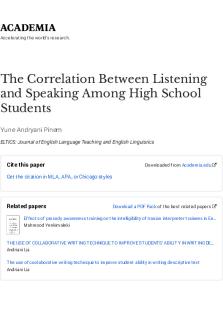Among School Children’s by WB Yeats PDF

| Title | Among School Children’s by WB Yeats |
|---|---|
| Course | English Literature |
| Institution | Aligarh Muslim University |
| Pages | 1 |
| File Size | 58.2 KB |
| File Type | |
| Total Downloads | 85 |
| Total Views | 140 |
Summary
"Among School Children's" key themes are best portrayed in the central action: A sixty-year-old government official is paying a visit to elementary school students. Every line of the poem is infused with the age-old lyrical themes of innocence vs experience, naiveté versus wisdom, and youth versus a...
Description
THEME OF AMONG SCHOOL CHILDREN BY W. B. YEATS "Among School Children's" key themes are best portrayed in the central action: A sixty-year-old government official is paying a visit to elementary school students. Every line of the poem is infused with the age-old lyrical themes of innocence vs experience, naiveté versus wisdom, and youth versus age. Yeats, who regularly dealt with events of death and loss in his earlier writing, became almost obsessed with those themes as he grew older and faced his own mortality in more concrete, less abstract terms. By this point in his career, Yeats was examining the consequences and effects of time's passing not just on the human body but also on the human spirit—both for the individual and for the race as a whole—always drawing on personal experience in his reflections. In Yeats’s hands, these timeless themes take on a profound significance, because while he views human life as tragic, his vision is not nihilistic. He never does actually enunciate what purpose human life may serve, but he does believe that there is a purpose. “Among School Children” illustrates how the individual might frustrate that purpose by imagining either that he is the master of his own destiny or that there is no such thing as destiny. Maud Gonne serves as a prime example of this frustration of purpose. The poet, who is condemned to remember the brightness and promise of her youth, must live with the meaningless fruits of her actions now that the heartbreak and frustrations of her commitment to revolutionary Irish political causes have taken their toll both on herself and others. By cutting her fulfillment short, she has cut all the rest of humankind short. Nor will Yeats exclude himself and others from the same condemnation. All fail in their choices and actions to face squarely the one insurmountable reality: Flesh ages, spirits flag, and human dreams wither. He thus accuses himself of having given up or given in (“Ihad pretty plumage once” but now am “a comfortable kind of old scarecrow”) and accuses nuns and mothers, as much as the Helens and Mauds of the world, of betraying the innocent, childlike spirit that fosters dreams and compels human choices. People unwittingly create false images of what it is to be human, thereby creating false hopes and expectations. Yeats suggests that since there is no choice but to move forward, one should imagine the fullness of each moment as having an inextricable harmony with all others. Life is like a dance that does exist independent of a dancer but has no shape or form without the dancers....
Similar Free PDFs

childrens literature
- 7 Pages

Childrens Literature
- 122 Pages

Fund wb - samenvatting
- 29 Pages

WB Aufgabe 13 - Lösungsvorschlag
- 3 Pages

Childrens Literature Task 1
- 4 Pages

Childrens Literature Issues
- 6 Pages

Childrens Lit Task 1
- 10 Pages
Popular Institutions
- Tinajero National High School - Annex
- Politeknik Caltex Riau
- Yokohama City University
- SGT University
- University of Al-Qadisiyah
- Divine Word College of Vigan
- Techniek College Rotterdam
- Universidade de Santiago
- Universiti Teknologi MARA Cawangan Johor Kampus Pasir Gudang
- Poltekkes Kemenkes Yogyakarta
- Baguio City National High School
- Colegio san marcos
- preparatoria uno
- Centro de Bachillerato Tecnológico Industrial y de Servicios No. 107
- Dalian Maritime University
- Quang Trung Secondary School
- Colegio Tecnológico en Informática
- Corporación Regional de Educación Superior
- Grupo CEDVA
- Dar Al Uloom University
- Centro de Estudios Preuniversitarios de la Universidad Nacional de Ingeniería
- 上智大学
- Aakash International School, Nuna Majara
- San Felipe Neri Catholic School
- Kang Chiao International School - New Taipei City
- Misamis Occidental National High School
- Institución Educativa Escuela Normal Juan Ladrilleros
- Kolehiyo ng Pantukan
- Batanes State College
- Instituto Continental
- Sekolah Menengah Kejuruan Kesehatan Kaltara (Tarakan)
- Colegio de La Inmaculada Concepcion - Cebu








